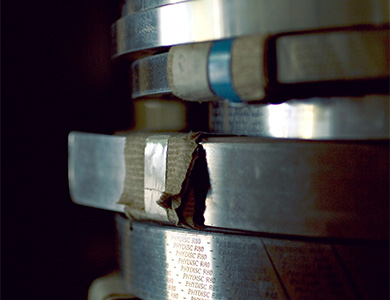Nickel at the core of the bimetal technology


This chemical element, particularly appreciated for its alloys capability with the Iron[1] for example, is widely used to compose the Bimetal material. This one is made of 2 layers of (mainly Fe+Ni) metal, having different expansion coefficients, and bonded together by lamination process.
The obtained strip has the property to change its curvature, under temperature variation. Playing with this curvature, DELTA CONCEPT develops its products, and fabricates components of thermostats, using the bimetal technology.
DELTA CONCEPT purchases its raw material in strips from 0,1 to 1mm thick, and from 5 to 50mm width.
The choice of the bimetal grade and of its dimensions is important. As it is made of 30% of Nickel, a quoted-on-the stock-exchange market raw material, its cost fluctuates, as a function of both the actual deposit and the international demand (from US$18,000 to US$20,000 per ton).
France owns 30% of Nickel stocks world reserves, thanks to its production in New Caledonia ! This makes the fortune of this overseas territory.
Five big world companies supply more than half of the worldwide offer: Norilsk (Russia), INCO (Canada), Falconbridge (Canada), Western Mining (Australia) and Eramet SLN (France).
Nickel production per country:
http://en.wikipedia.org/wiki/Nickel
| Country | thousands of tons | % total |
| Russia | 300 | 23 |
| Australia | 218 | 17 |
| Canada | 162 | 13 |
| France (New Caledonia) | 112 | 9 |
| Indonesia | 103 | 8 |
| 5 countries total | 897 | 70 |
| World total | 1284 | 100 |
Impact and costs control
The variation of this raw material price impacts our own production costs. In order to minimize them, we calculate the bimetal as soon as possible in our customer project phase, so to make it as accurate and as low cost as possible. The taken into account criteria are as follows:
- The bimetal grade to use,
- The band thickness,
- The weight of the piece, one it is cut.
Examples of applications at DELTA CONCEPT
They are numerous, and they can be split in two main categories : the slow deflection bimetals and the snap action bimetals, which are integrated in mechanical or electrical sub-assemblies.
This variety of applications allows our company to develop and to fabricate mechanical actuators, electrical circuit breakers, regulators and security flaps.
See our on-specification developments.
Other examples for Nickel use[2].
To know more about the Nickel :
– http://en.wikipedia.org/wiki/Nickel
[1] « Zoom on iron-nickel alloys. They are used for their physical properties, which are sometimes surprising. For example, the invar, an iron-nickel alloy containing 36+% of nickel (FeNi36), is almost not expandable under 200°C. It is used in Cryogenics (for tanks of methane carriers), in laser physics (structure elements) or in cathodic ray tubes (shadow mask).
The used physical properties of iron-nickel alloys are the magnetic properties (high magnetic permeability alloys, low Curie point alloys, magnetostrictive alloys), the elasticity properties (low thermoelastic rate alloys), as well as their extraordinary expansion properties (no-expansion or controlled expansion alloys) »
Source : http://en.wikipedia.org/wiki/Nickel
[2] The nickel salts (hydroxycarbonate, chloride, sulphate…) are used in different industries, as electronics, catalysis, electroplating.
The nickel is also used in the cathode of nickel-manganese dioxide alkaline batteries, and of nickel-cadmium alkaline, nickel-metal hydride, and nickel-zinc storage batteries .
Electric guitar strings: the nickel is used for certain kinds of strings.
It is used in jewelry with gold, in order to obtain a better mechanical resistance, as well as original colors. Thus, copper+nickel+gold make yellow-gold or pink-gold, and nickel+gold make white-gold.
Another “historical” use of nickel is for money coins, where the quality of malleability and resistance of the product are particularly appreciated. Thus nickel is found in american and canadian coins, as well as 2 Euros coins.
It is interesting to state that as a transition metal, the nickel could be replaced by other elements: it is mainly used for its extraction and disposal low cost, compared to other technically possible solutions.
It is also used in the dental floss. source: http://en.wikipedia.org/wiki/Nickel